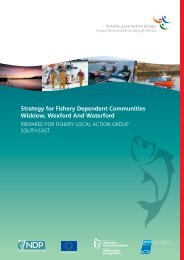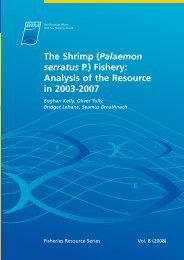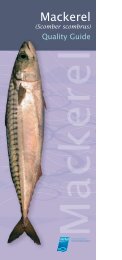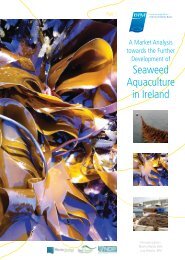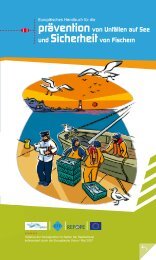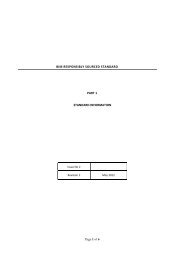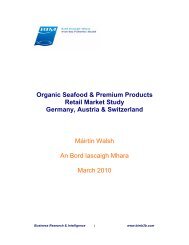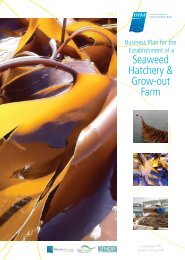Cultivating Palmaria palmata - Bord Iascaigh Mhara
Cultivating Palmaria palmata - Bord Iascaigh Mhara
Cultivating Palmaria palmata - Bord Iascaigh Mhara
You also want an ePaper? Increase the reach of your titles
YUMPU automatically turns print PDFs into web optimized ePapers that Google loves.
Fig. 7.2. An example of spore survival during the first two weeks after release.<br />
Reproductive <strong>Palmaria</strong> material was collected during low spring tides in Strangford Lough in<br />
April 2010 from different hieghts of the shore. Algae were collected from the lower intertidal<br />
(IT) and upper subtidal (ST). Error bars indicate standard deviation.<br />
All hatcheries reported excellent spore release for most sporulation trials in each reproductive season. However,<br />
frequently - but not always - a mass mortality of spores was observed during the first 7 days after spore release<br />
(Fig. 7.2). Comparison of procedures, spore release rates and subsequent sporeling growth among the three<br />
hatcheries during the reproductive season of 2008/09 showed little correlation with factors that might affect the<br />
success or loss of seeded spores. In the following reproductive season (2009/10), a comprehensive programme<br />
of experiments was carried out by all partners to investigate the factors affecting spore survival and<br />
development, including water quality, nutrient and oxygen supply, harmful chemicals, grazers, and exposure of<br />
reproductive thalli to air on the shore prior to collection.<br />
The results from all hatcheries showed that spores survive under a range of conditions after release. Overall,<br />
spore survival varied with the source of collected algal material but was generally low, i.e. 20-40%. None of the<br />
factors investigated appeared to be a „key‟ factor that ensured a high survival rate. Mass mortality thus seems to<br />
be natural for <strong>Palmaria</strong> and is counterbalanced by high numbers of spores produced over a fertile season of<br />
about 4 months. To ensure a dense and even settlement of spores on the culture string, it was found that about<br />
150 g of reproductive <strong>Palmaria</strong> tissue is needed for seeding a net or frame collector.<br />
7.1.2 Development of spores on culture string in the hatchery<br />
The spores which survived the first week after release settled well and firmly on culture string. Different culture<br />
string (Kuralon string from Korea and from China, spun polyester string, PV string) was used for settlement trials<br />
(Fig. 7.3). No significant differences in settlement and ongrowth were found. The string, however, should be<br />
washed thoroughly before use to leach out potentially hazardous chemicals, which may remain after<br />
manufacture and storage. Spores usually settled well on the conduit pipe used as frames for holding the culture<br />
string, and the frames became overgrown by sporelings.<br />
39



